BACKYARD BIRDING IN MERIDA, YUCATAN AND BEYOND – SPLISH SPLASH, PREEN, and CHICKEN SKIN, PART 2 OF 2
Remember in part one we learned feathers occur in rows only to cover about 30% of most birds bodies? Bare skin exists between those tracts. When birds bathe, they can repeat the wash and preen cycle many times during one bath.
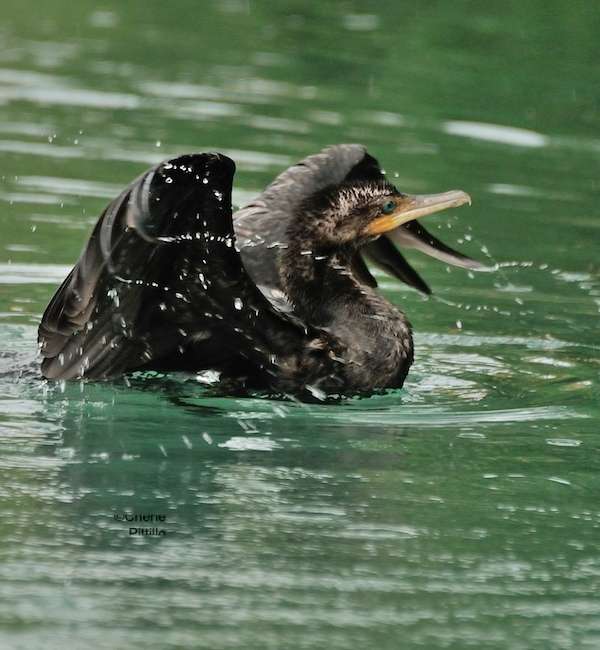
How surprised I was to watch Cattle Egrets bathe. I saw each egret sit in the water, give ONE vigorous splash with its wings, and then sit for several minutes before it sat upright and then finally stood to preen. In my data research, I didn’t encounter this one splash method and whether this bird meditated or not. However, maybe the egrets sensed danger nearby or maybe the egrets returned to bathe more after I left from a hidden blind.

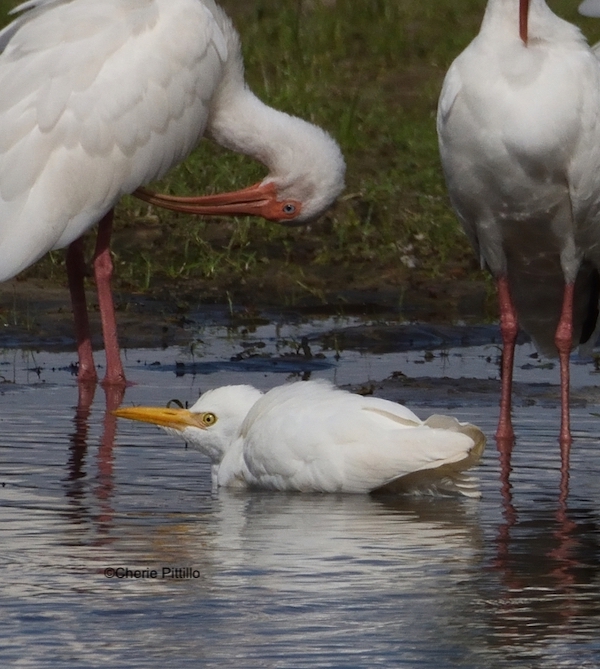
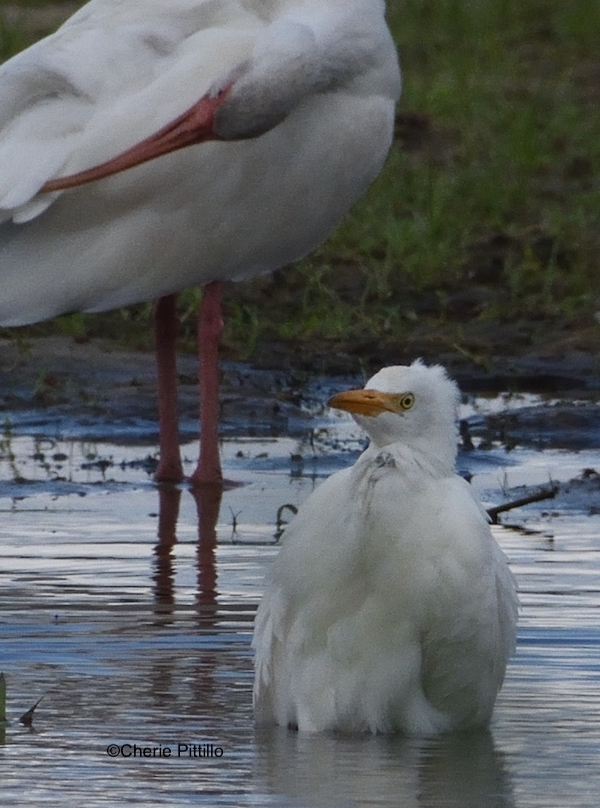
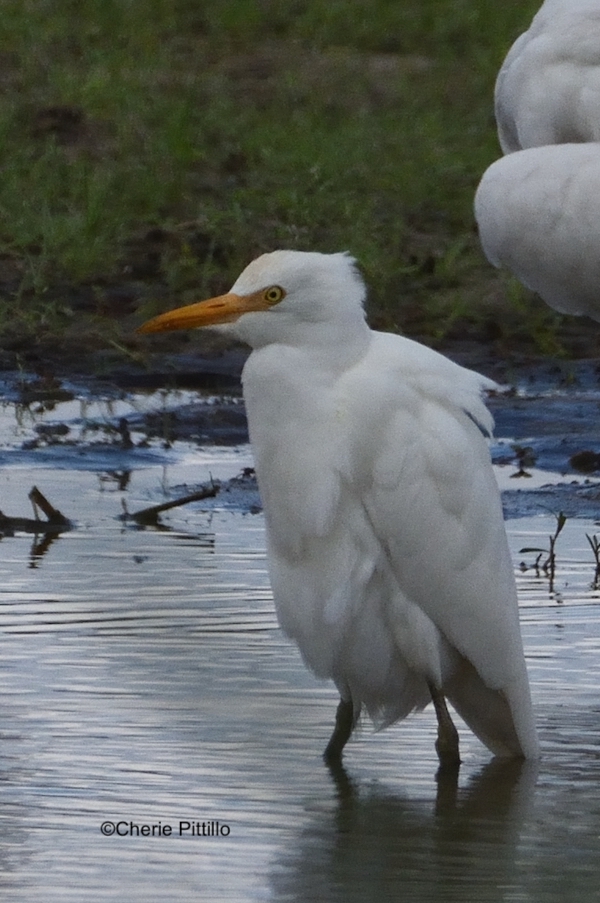
In addition to water baths, birds may also sun bathe and/or dust bathe or do both. Even those methods vary depending on the family.
SUN BATHING
Early one morning I watched a Groove-billed Ani smoothly sail from one tree to another, land, zigzag up a few limbs, and settle on a branch. How it seemed to welcome the sun as it spread its wings and tail toward it! First, I thought, “Ani, get your sun.” I felt grateful as it radiated a “soul-ar” experience for both of us.

For examples in this article, the cuckoo cousins, the Smooth-billed Anis, and the Greater and Lesser Roadrunners also perform sunbathing. Look closely to see fluffy feathers with the Lesser Roadrunner resting on a branch near Ria Lagartos Biosphere Reserve. I probably wouldn’t have recognized what it was doing until I photographed the Greater Roadrunner in the US.
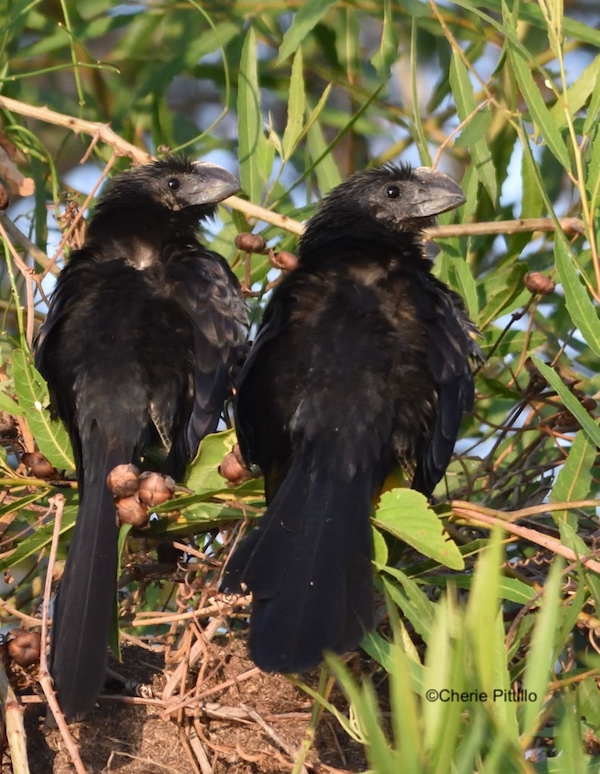
PHOTO 8 What is this Lesser Roadrunner doing


Studies indicate the Greater Roadrunner loses 7 degrees F on cold nights. The heart rate and metabolism slow down like a mini-hibernation, called torpor. During the day, the roadrunner exposes dark feathers and skin on its back in the sun to warm up its solar panel, a.k.a. thermoregulator. This passive action heats up the blood and saves about 550 calories per hour to return the body temperature to a normal 101 degrees F.
Many bird species practice daily torpor. Their body temperatures lower several degrees while they roost. Some examples include hummers, swifts, martins, pigeons, swallows, roadrunners, Red-tailed Hawks, and probably many other species. But I digress.
When we also see vultures with their spread wing posture, such as this Turkey Vulture, we assume its warming up before taking flight. But several theories exist on the benefits of sunning:
▪ sunning may be a pleasurable stimulus during heat absorption
▪ it may make parasites disperse and easier to remove during preening
▪ birds can dry wet plumage quicker
▪ it may help with Vitamin D production
▪ it may support molting
▪ sunning may also increase preen gland secretion
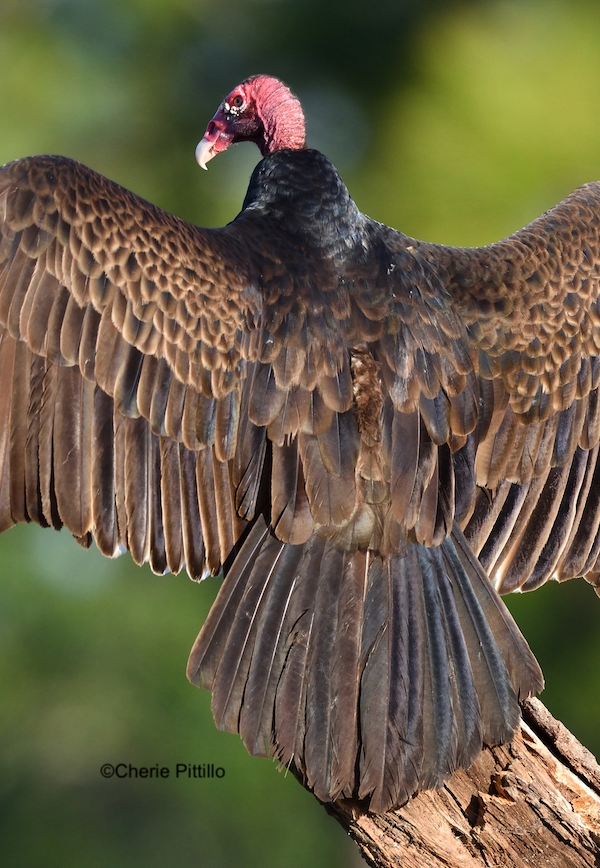
In addition to vultures with their spread wing posture, we often see cormorants and anhingas drying or sunning their wet or dry wings.
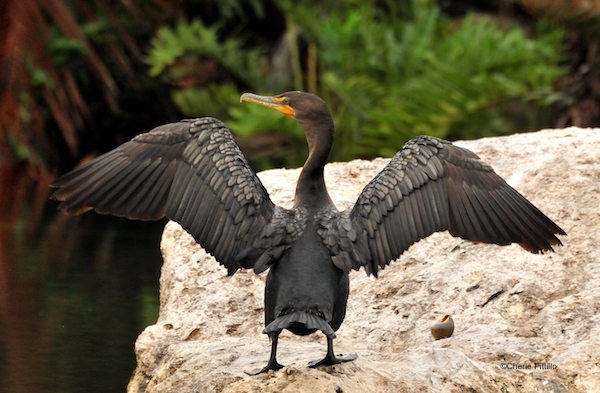
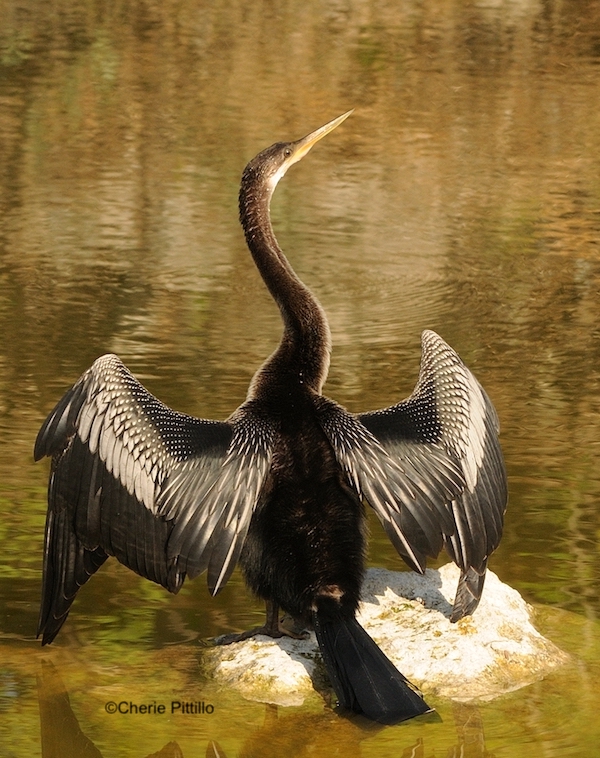
In the case of four anhinga species, which live in the tropics or subtropics, sunbathing is necessary for thermoregulation. The anhinga generates less heat than a cormorant. Forty species of cormorants, can tolerate cooler habitats and can live throughout most of the world.
For decades I’ve read or heard that cormorants and anhingas lacked preen glands. I often saw these waterbirds with outstretched wings and believed what I had read. I stood dumbfounded as I watched an anhinga at Merida’s Aqua Park use its bill to reach the preen gland and then rub the waxy substance over its body feathers. The substance contains waxes, fatty acids, fats, and water. It also seems that some secretions contain Vitamin D precursors. When the oil spreads over feathers, sunlight exposure activates the Vitamin D.
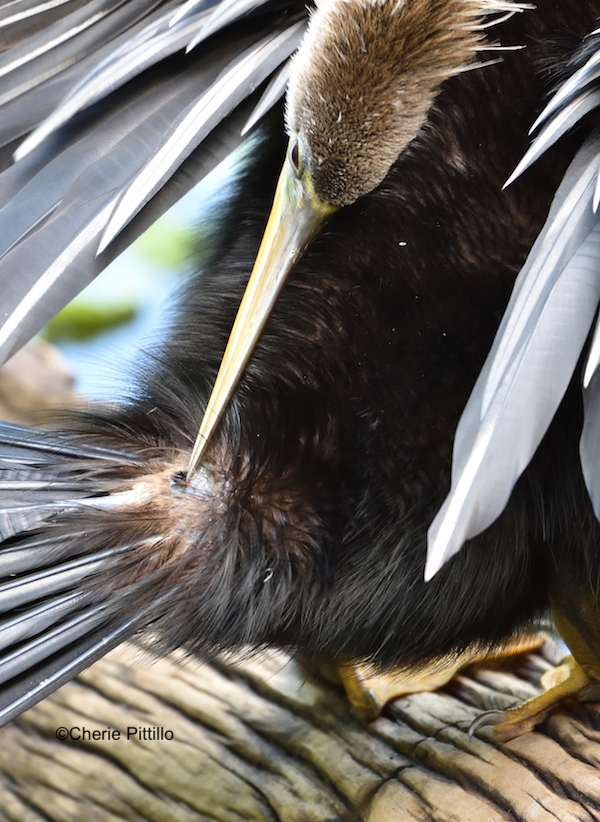
Both cormorants and anhingas have wettable wings. The Cornell Lab of Ornithology suggests anhinga wings are more permeable to water and take longer to dry.

Anhingas have low metabolic rates with high rates of body heat loss. When they spread their wet or dry wings, scientists believe that action is to regulate their body temperature while cormorants spread their wings for drying only.
As far as the cormorant, some scientists theorize their feathers are waterproof except the wing feathers. With wettable wings the cormorant can dive deeper than certain other species while the other body feathers provide insulation. In fact, one cormorant species can dive to a depth of 380 feet (116M) and hold its breath for 6.3 minutes.
DUST BATHING
Birds scrape their feet in dry dirt or sand to make a wallow to lie in and vigorously shake their wings to spread dust over their bodies. They may also rub their heads to coat short cheek feathers. Then they may sun or preen to continue grooming their feathers. Similar to water baths, dusting routines vary for different species. Some may take several daily dust baths; some dust alone; others dust in flocks.
And then the Greater Rhea differs in its dusting routine. It may sit on the ground, pick up dirt in its bill and throw dust on its wings and back and not use the vigorous wing fluffing. Or, it may pick up dust and then drop it next to its body. It seems males do this which may be a displacement behavior. Often the rhea sleeps after dusting and preening.
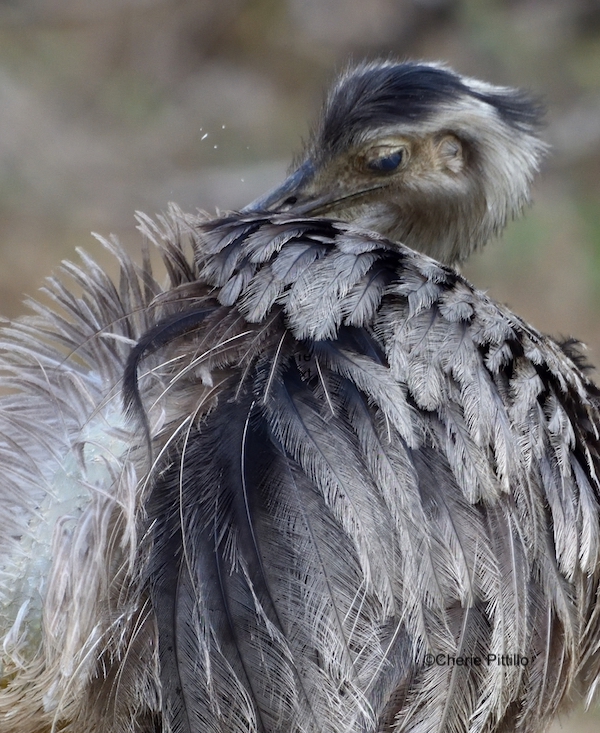
Dust absorbs excess oil and can be shed along with dry skin and other debris. For example, if a quail cannot dust, their feathers quickly become oily and matted. Also regular dusting may help smother lice, feather mites, and other parasites.
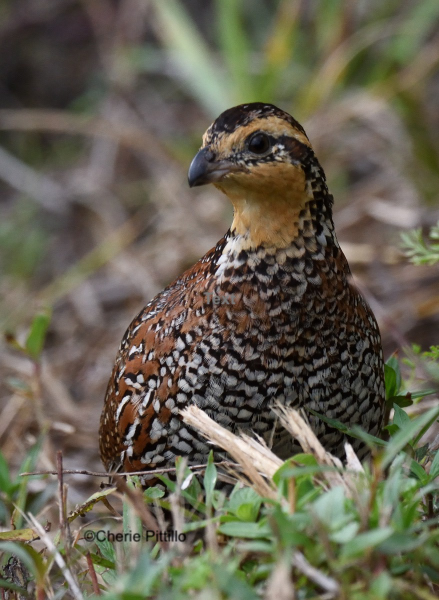
However, surprising research in 2019 indicates that certain feather mites mainly feed on bacteria and fungi and do not destroy feathers! Over 2,500 species of mites live inside feather quills, in down feathers, and on wing and tail feather vanes. The vane-dwelling mites were believed to be parasitic and harmful like feather lice. Now this study indicates bird feathers provide food for the mites and the mites provide healthier plumage. Wow, finally a study “in vane.”
In arid areas dust baths may be the only method. Certain species such as wrens and sparrows may use a water bath followed with dusting baths. Several species like some hawks, herons, and Amazon parrots use “powder down,” specialized feathers which break down at the tip to provide a permanent supply of talc-like dust for cleaning.
CLEAN OFF THE CLUTTER IN YOUR BRAIN AND GET DOWN WITH NATURE!
LINK to PART 1
SPECIES LIST:
Neotropic Cormorant, Phalacrocorax brasilianus, Cormorán Neotropical (Spanish), Mach (Mayan)
Cattle Egret, Bubulucus ibis, Garza Ganadera (Spanish)
White Ibis, Eudocimus albus, Ibis Blanco (Spanish), Koko (Mayan)
Groove-billed Ani, Crotophaga sulcirostris, Garrapatero Pijuy (Spanish), Ch’ik bul, K’usay (Mayan)
Smooth-billed Ani, Crotophaga ani, Garrapatero Pico Liso (Spanish), Ch’ik (Mayan)
Greater Roadrunner, Geoccyx californianus, Correcaminos Mayor (Spanish)
Lesser Roadrunner, Geoccyx velour, Correocaminos Tropical (Spanish), Xtuntun kinil (Mayan)
Turkey Vulture, Cathartes aura, Zopilote Aura (Spanish), Boox pool ch’oom (Mayan)
Double-crested Cormorant, Phalacrocorax auritus, Cormorán Orejón (Spanish), Mach (Mayan)
Anhinga, Anhinga anhinga, Anhinga americana (Spanish), Chowak kaal (Mayan)
Greater Rhea, Rhea americana, Ñandú, Ñandú Común (Spanish)
(Eastern) Northern Bobwhite (Quail) Colinus virginianus floridanus, Codorniz-cotui Norteña (Spanish)
DISCLAIMER: REFERENCES DO NOT ALWAYS AGREE ON INFORMATION:
Hibernation, The Handbook of Bird Biology, Sal a Pajarear Yucatán, Bird & Reserves of the Yucatan Peninsula, A Guide to the Birds of Mexico and North Central America, The Sibley Guide to Birds, Lives of North American Birds,Fowler’s Zoo and Wild Animal Medicine, Volume 8, Revista Brasileira de Ornitologia, The Journal of Experimental Biology 204, 4081–4092 (2001)
https://birdsoftheworld.org/bow/species/norbob/cur/systematics#subsp
https://sora.unm.edu/sites/default/files/journals/auk/v087n01/p0091-p0099.pdf
https://www.academia.edu/3201250/Processes_in_feathers_caused_by_bathing_in_water
https://web.stanford.edu/group/stanfordbirds/text/essays/Bathing_and_Dusting.html
https://www.startribune.com/nature-notes-bird-bathing-has-a-purpose-more-than-cleaning/387839031/
https://faculty.weber.edu/jcavitt/Feather1.pdf
https://www.britannica.com/science/integument/Reptiles#ref315423
https://academic.oup.com/condor/article-abstract/42/2/112/5251053
https://www.sciencedaily.com/releases/2019/03/190328150700.htm
Elder, William H. Oil Gland of Birds. The Wilson Bulletin, 66, (1), 6-31, March, 1954
http://www.birdsofseabrookisland.org/taxa/t000d-evidence4.html
https://web.stanford.edu/group/stanfordbirds/text/essays/Spread-Wing_Postures.html
https://jeb.biologists.org/content/jexbio/204/23/4081
https://birdsoftheworld.org/bow/species/anhing/cur/behavior#locom
https://birdsoftheworld.org/bow/species/doccor/cur/behavior#locom
https://birdsoftheworld.org/bow/species/phalac1/cur/introduction
https://birdsoftheworld.org/bow/species/anhing3/cur/introduction
https://www.nps.gov/ever/learn/nature/anhinga.htm
https://sora.unm.edu/sites/default/files/journals/auk/v087n01/p0091-p0099.pdf
https://www.academia.edu/3201250/Processes_in_feathers_caused_by_bathing_in_water
https://web.stanford.edu/group/stanfordbirds/text/essays/Bathing_and_Dusting.html
https://www.startribune.com/nature-notes-bird-bathing-has-a-purpose-more-than-cleaning/387839031/
https://faculty.weber.edu/jcavitt/Feather1.pdf
https://www.britannica.com/science/integument/Reptiles#ref315423
https://academic.oup.com/condor/article-abstract/42/2/112/5251053
https://www.sciencedaily.com/releases/2019/03/190328150700.htm
Elder, William H. Oil Gland of Birds. The Wilson Bulletin, 66, (1), 6-31, March, 1954
Cherie Pittillo, “nature inspired,” photographer and author, explores nature everywhere she goes. She’s identified 56 bird species in her Merida, Yucatan backyard view. Her monthly column features anecdotes about birding in Merida, Yucatan and also wildlife beyond the Yucatan.
Contact: [email protected] All rights reserved, ©Cherie Pittillo
